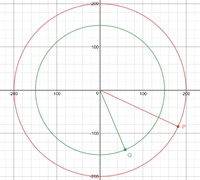If I were to use vector arithmetic, I would give the vectors as follows:
[MATH]\vec{P}=200\langle \cos((90-115)^{\circ}),\sin((90-115)^{\circ}) \rangle=\langle 200\cos(25^{\circ}),-200\sin(25^{\circ}) \rangle[/MATH]
[MATH]\vec{Q}=150\langle \cos((90-157)^{\circ}),\sin((90-157)^{\circ}) \rangle=\langle 150\cos(67^{\circ}),-150\sin(67^{\circ}) \rangle[/MATH]
And so the distance \(d\) between them (in km) is:
[MATH]d=\sqrt{(200\cos(25^{\circ})-150\cos(67^{\circ}))^2+(200\sin(25^{\circ})-150\sin(67^{\circ}))^2}\approx133.8[/MATH]
If I were to use the Law of Cosines:
[MATH]d=\sqrt{200^2+150^2-2\cdot200\cdot150\cos((157-115)^{\circ})}\approx133.8[/MATH]

